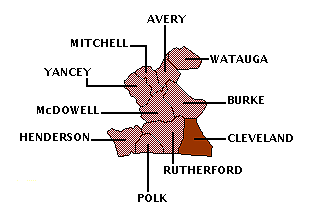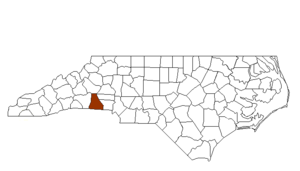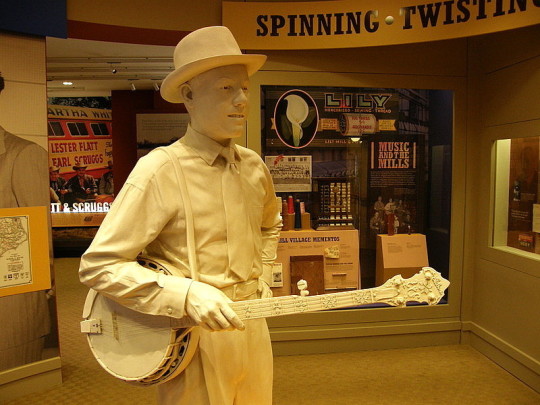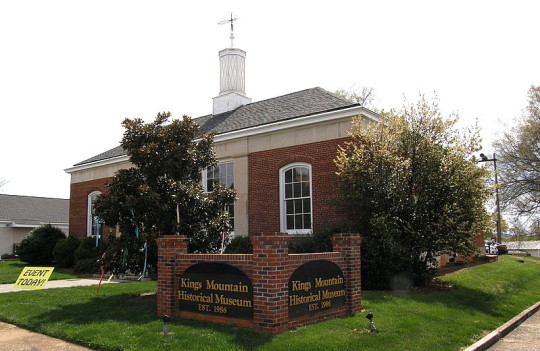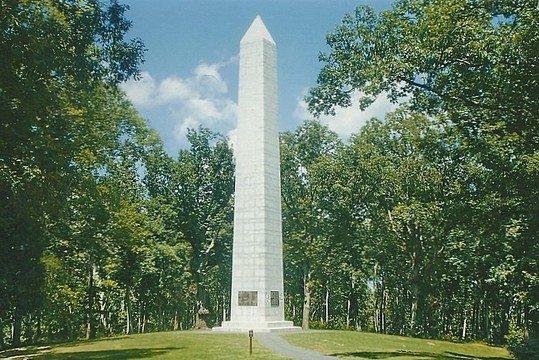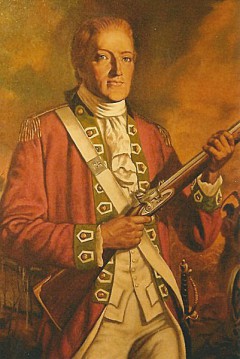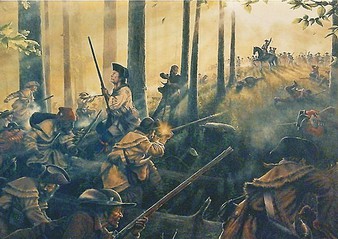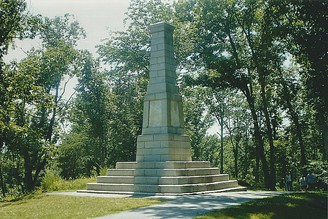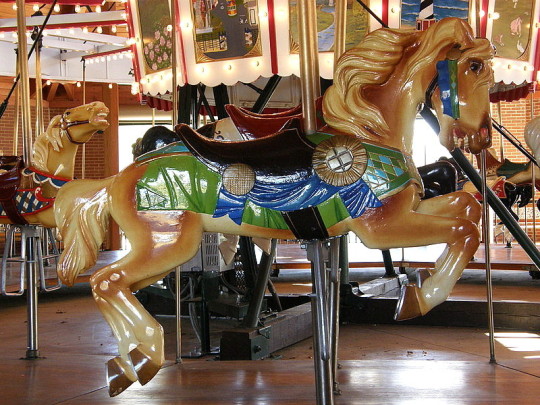CLEVELAND COUNTY
Scroll down this page or click on specific site name to view features on the following Cleveland County attractions/points of interest:
Don Gibson Theatre, Earl Scruggs Center, Kings Mountain Fire Museum, Kings Mountain Historical Museum, Kings Mountain National Military Park, Shelby City Park
Fast facts about Cleveland County:
Created in 1841, the county is named for Benjamin Cleveland, one of several patriot commanders who led militiamen to victory at the Battle of Kings Mountain.
The county seat is Shelby, named for Isaac Shelby, another Revolutionary War officer. Other communities include Belwood, Boiling Springs, Earl, Grover, and Mooresboro.
Cleveland County’s land area is 464.63 square miles; the population in the 2010 census was 98,078.
It is worth noting that Thomas Dixon, Jr., author of The Clansman (the source of the 1915 film Birth of a Nation) was a resident of Cleveland County.
Shelby
Shelby native Don Gibson had his name in lights in the 1950s, 60s, and 70s, charting such country classics as “Oh, Lonesome Me” and “Sea of Heartbreak” and penning such country standards as “Sweet Dreams” and “I Can’t Stop Loving You.” The singer/songwriter’s name is back in lights again, this time on the marquee above the former State Theatre, an art deco style movie house built in 1939. Like many small town movie palaces, this one closed its doors in the 1970s. Thanks to the vision and verve of a revitalization organization known as Destination Cleveland County, however, the completely refurbished building has reopened its doors as the Don Gibson Theatre. Since 2009, the 400-seat venue has seen a wide variety of nationally-known acts make their way to the stage, performing everything from rock-and-roll, jazz, and country music to bluegrass, beach, and big band. Gibson, nicknamed “The Sad Poet,” was inducted into the Country Music Hall of Fame in 2001 and display cases in the lobby showcase personal items and memorabilia. 704-487-8114
Shelby
One of the most famous names in country music is that of Earl Scruggs, a Cleveland County native who is best remembered for introducing the distinctive three-finger banjo-picking style that revolutionized bluegrass music. The Earl Scruggs Center honors the man and his music. The facility opened in January, 2014 in the former Cleveland County courthouse in the heart of uptown Shelby. The Center is high-tech all the way, telling the story of the Country Music Hall of Famer through a variety of interactive displays, videos, still photographs, and memorabilia. Visitors accompany Scruggs as he journeys from his days as a 40-cents-an-hour employee at the Lily Cotton Mill to his initial success as a member of Bill Monroe’s Original Bluegrass Band; from his subsequent two-decade partnership with guitarist and vocalist Lester Flatt and their huge popularity during the 1950s and 1960s to their breaking up in 1969 over artistic differences; and ending with his continuing efforts to find new and different ways to entertain younger audiences beginning in the 1970s.
While the Center's spotlight shines brightly upon Earl Scruggs, it also does an admirable job of illuminating the history of the city, county and region that so influenced the musician. With more than 16,000 artifacts from which to draw, the Center deftly weaves the story of Earl Scruggs with that of his boyhood home. Exhibits touch on several of the county’s early industries, with an obvious emphasis given to textiles. Like many neighboring counties, Cleveland County was a major player in the textile industry for over 100 years, with more than a dozen mills located within its borders. The county also had a reputation during the late 19th and early 20th century as a health resort area. Town names such as Boiling Springs, Patterson Springs, Poplar Springs, and Lithia Springs are reminders that thousands of visitors were drawn to the county each year to benefit from the area’s abundant mineral waters. Most of the county's lavish resort hotels closed during the Depression.
Museum visitors will likely recognize the names of a number of Cleveland County natives who earned a place in North Carolina history or in the popular culture of their time. Shelby native Thomas Dixon, Jr. authored the controversial novels The Leopard’s Spots and The Clansman, which served as the basis for D. W. Griffith’s epic film Birth of a Nation. In addition to writing, Dixon was a lawyer, legislator, preacher, lecturer, actor, and motion picture producer. Although he enjoyed great wealth during his lifetime, he died a pauper in 1946. Another Cleveland County native was W. J. Cash, author of The Mind of the South (1941), an insightful and influential study about the philosophy, temperament, and social customs of the South.
On the political front, Cleveland County was home to O. Max Gardner, who served as North Carolina governor from 1929 to 1933. Elected on the eve of the Great Depression, he ran unopposed in his bid for the state’s highest office. Another notable Cleveland County resident was Clyde R. Hoey (pronounced HO-ee), a unique figure in North Carolina politics. Although he received little formal public education, Hoey landed a job at the Cleveland Star at the tender age of 14. Before his 21st birthday, he was owner, editor, and publisher of said newspaper. Even at this early age, however, he had already taken his first steps in what would be a lifelong career in politics, having been elected to the N. C. House of Representatives before he was old enough to vote. In a life given to public service, Hoey became the only Tar Heel to serve North Carolina in both state houses, both houses of Congress, and as governor. Dixon, Cash, Gardner, Hoey, and Scruggs are all buried in nearby Sunset Cemetery. Hours are 10-6 Wednesday, 10-4 Thursday through Saturday, and 1-4 Sunday. Closed major holidays. Admission charged.
Kings Mountain
What to do with an old, 1938 Ford fire truck? That was the “burning” question that Kings Mountain fire chief Gene Tignor and volunteer firefighter Jerry White pondered back in the mid-1970s. The answer was to establish a museum in which the truck would be one of the principal artifacts. The facility opened in 1976 and has been added to and improved upon ever since, with nearly all of the work being done by paid and volunteer firefighters. Along with several trucks, the Kings Mountain Fire Museum displays the first pull-by-hand hose cart, first wooden ladder, and first fire pole used in the city, as well as other miscellaneous equipment. Call 704-734-0555 to schedule a tour.
Kings Mountain
From storage space in the attic of the old City Hall to a much more welcoming environment in a restored post office building, the Kings Mountain Historical Museum has been preserving and presenting local history for more than 25 years. Its exhibits are drawn from a diverse collection of artifacts that includes 19th century clothing, textiles, artifacts from World Wars I and II, and more. As most visitors come from local communities, the Museum rotates exhibits twice a year so that there will be new items for returning guests to see. Moved to the site from nearby locations are two two houses, the antebellum Robert Barber log house and the circa 1876 George Washington Cornwell House, a frame structure built in the late Greek Revival Style. Hours are 10-4 Tuesday through Saturday. Admission is free. 704-739-1019
South of Kings Mountain
Let's make this clear right up front: Kings Mountain National Military Park is located in South Carolina, not North, but the site is of such historic significance to the Tar Heel State that it demands inclusion on this website. Moreover, although the military park is clearly within South Carolina’s borders today, at the time of the battle, the site may actually have been within North Carolina’s borders anyway. The important thing is that the park preserves the site of a major Patriot victory of the Revolutionary War, regarded by many as the “turning point” of the Southern campaign.
Things looked bleak for the cause of American independence in the fall of 1780. While Patriot and English forces held each other in check in the North, a British initiative in the South, begun in the spring of 1780, seemed an unstoppable juggernaut. Charleston, America’s largest Southern seaport, had fallen in May. Over 5,000 patriot forces were captured during the siege. Within months, the British controlled most of South Carolina and Georgia. In August, a numerically superior American force under General Horatio Gates was put to flight at the battle of Camden, South Carolina. Under the command of Lord Charles Cornwallis, the British boldly entered into North Carolina. Overcoming the surprisingly stubborn resistance offered by a small force of militia, Cornwallis and his army entered Charlotte September 26, 1780.
British fortunes rapidly changed, however. British Major Patrick Ferguson, with a force of over 1,000 Loyalists, protected Cornwallis’ left flank. Ferguson was charged with recruiting and training for combat what was believed to be a high number of Tories living in the North and South Carolina backcountry. To quell the resistance of frontier patriots, Ferguson threatened to destroy settlements along North Carolina’s westernmost fringe – today’s southeastern Tennessee. The hardy frontiersmen living in the Watauga, Holston, and Nolichucky river valley settlements opted not to wait for Ferguson to carry out his threat to “lay their country waste with fire and sword.” Instead, these so-called “over-mountain” men quickly gathered to meet their enemy head on. As a precaution against attack, Ferguson made his encampment atop Kings Mountain. The wide plateau at its summit, roughly shaped like a footprint when viewed on a map, seemed an ideal location. Boasted Ferguson, “I am on Kings Mountain and God Almighty cannot drive me from it.” Events on the afternoon of October 7, 1780 proved him wrong.
Sentries failed to detect the arrival of American contingents under the commands of William Campbell, Isaac Shelby, Charles McDowell, and John Sevier. Acting in unison, the frontiersmen encircled the pinnacle and attacked from all sides at once. Attaining the summit, Colonel Campbell exhorted his troops to “Shout like hell and fire like devils!” The fighting was fierce and the outcome quickly decided, with the Americans gaining a crucial victory. Patriot forces suffered 28 killed and 62 wounded. Loyalist casualties were staggering: 225 killed, 163 wounded, and 698 taken prisoner. Ferguson, the only English soldier engaged in the battle, was killed while attempting to rally his troops.
The park’s Visitors Center offers a 27-minute film detailing the events of the battle and showcases a small number of exhibits and artifacts. Ranger talks and walks are often scheduled. An easy to moderate, mile-and-a-half paved loop trail ascends to the top of the plateau, where the Centennial Monument and the towering United States Monument commemorate the American victory. Other markers along the trail explain various actions that took place. A stone tablet and a pile of rocks mark the place where Major Ferguson fell. Dedicated in 1930, the inscription is Ferguson’s marker is poignant: “This memorial is from the citizens of The United States of America in token of their appreciation of the bonds of friendship and peace between them and the citizens of the British empire.”
The park entrance is on South Carolina highway 216, approximately two miles south of Exit 2 on I-85 in Cleveland County. The site is open year-round, except Thanksgiving, Christmas, and New Year’s Day. Hours are 9-5 Monday-Friday and 9-6 weekends from Memorial Day through Labor Day. Admission is free. Restrooms and picnic facilities are located at the Visitors Center. Camping facilities are on site, and hiking and horseback riding trails connect with the adjacent Kings Mountain State Park. Living history demonstrations are held on various weekends throughout the year and focus on typical 18th century activities; militia drills and musket firings are also frequently scheduled. The largest encampment and tactical demonstrations are held annually on the weekend nearest the anniversary of the battle. 864-936-7921
Shelby
Two grand examples of vintage amusement rides are found at the Shelby City Park – the circa 1919 carousel built by the Hershell Spillman Company of North Tonawanda, NY, and the 1952 train built by the Miniature Train Company. Purchased by the City of Shelby in 1952, the merry-go-round features 32 “jumpers.” Twenty-nine of the brightly-painted, hand-carved horses are original and three are replacements. A total restoration of the carousel was completed in 1998, which included a rebuilding of the mechanism, repairing and repainting the horses and decorative rounding boards, the purchase of an authentic Band Organ, and the construction of the handsome Anne Dover Bailey Pavilion. Soon after the city purchased the carousel, the Rotary Club bought the miniature train, an award-winning, scaled-down replica of a real F3 Diesel Streamliner, displaying the characteristic sleek lines of the originals. Like the carousel, the train underwent a restoration in 2002, and a “depot” was added. Rides on either the train or the carousel are a mere 50 cents per person. The rides operate on a seasonal schedule. March through May and September through November, hours are 1-6 Thursday through Saturday and 1:30-6 on Sunday. June through August, hours are 10-1 and 5-8 Tuesday through Friday, 1-6 on Saturday, and 1:30-6 on Sunday. December through February, only the carousel is in operation. Hours are 1-5 Friday and Saturday and 1:30-5 on Sunday. The Foothills Merry Go Round Festival is held annually the last weekend of April. 704-484-6811
Cleveland County is bordered by BURKE, GASTON (Region Seven), LINCOLN (Region Eight), and RUTHERFORD counties.
Return to REGION NINE HOME PAGE.
Return to GEOGRAPHIC REGIONS HOME PAGE.

